Explore the integral role of wave traps in power systems, their operation, design types, applications, and future prospects.

Introduction to Wave Traps
In the world of electrical power transmission and distribution, one specific device plays a crucial role in maintaining the integrity and efficiency of the system: the Wave Trap. Often overlooked but fundamentally significant, wave traps are essential components designed to ensure seamless operation of power networks.
Understanding Wave Traps
A wave trap, also known as a high-frequency stopper, is an electronic device installed in power substations. Its main function is to block high-frequency communication signals, approximately ranging from 30 to 500 kHz, sent on the line from entering the substation equipment. It allows low-frequency power signals (50 or 60 Hz), which is the core of the power system, to pass unhindered.
Working Principle of Wave Traps
The operation of a wave trap is based on the concept of resonant frequency, a characteristic of LC (Inductor and Capacitor) circuits. Essentially, the wave trap is designed to resonate or “tune in” to the frequency of the communication signals, thereby drawing these signals into the trap. This tuning mechanism effectively isolates the high-frequency signals, preventing them from interfering with the power equipment within the substation.
- 1 The wave trap is connected in series with the transmission line.
- 2 High-frequency communication signals are attracted to the wave trap.
- 3 These signals are then “trapped”, preventing them from entering the substation and causing potential interference.
Importance of Wave Traps in Power Systems
Wave traps are integral for several reasons. They allow for the use of Power Line Carrier Communication (PLCC), a system that enables the transmission of telecommunication signals over power lines. By trapping high-frequency signals, wave traps protect substation equipment from possible damage or interference caused by these signals. Wave traps also play a vital role in fault detection and location identification within the power system network.
The following section will delve deeper into the technicalities of wave traps, their designs, and real-world applications, enhancing our understanding of this significant device in power systems.
Design and Types of Wave Traps
Wave traps are typically comprised of a series inductor (L) and a parallel capacitor (C). There are two primary types of wave traps based on their design: the tuned wave trap and the broadband wave trap.
- Tuned Wave Traps: These are designed to trap a specific range of frequencies. They are tuned to resonate at the carrier frequency, absorbing the communication signals and thus, preventing them from entering the substation.
- Broadband Wave Traps: Unlike tuned wave traps, these are not frequency-specific. Broadband wave traps can trap a wide range of frequencies, making them more versatile but also more complex.
Real-world Applications of Wave Traps
Wave traps are employed in various applications within power systems. They are crucial for the proper functioning of Power Line Carrier Communication (PLCC), which enables data transmission over power lines. In addition, they are employed in the protection of transmission lines where they aid in blocking carrier signals, thereby enabling differential protection.
Challenges and Future Prospects
While wave traps offer significant advantages, they also present some challenges. Tuning wave traps accurately to the desired frequency requires precision, and the broadband type can be complex to design and install. Furthermore, the surge impedance loading of the line, loading condition, and line length may affect the performance of a wave trap.
However, with advancing technology, there’s potential for overcoming these challenges. Improvements in the design and manufacture of wave traps can enhance their efficiency and adaptability, paving the way for even more reliable and versatile power systems in the future.
Conclusion
In conclusion, wave traps play a pivotal role in modern power systems. Their ability to trap high-frequency signals and protect vital equipment within power substations is instrumental in ensuring the smooth operation of power transmission and distribution networks. Despite the challenges associated with their design and operation, the future holds promise for the continuous evolution and improvement of wave traps, thereby contributing to more robust and efficient power systems globally.

